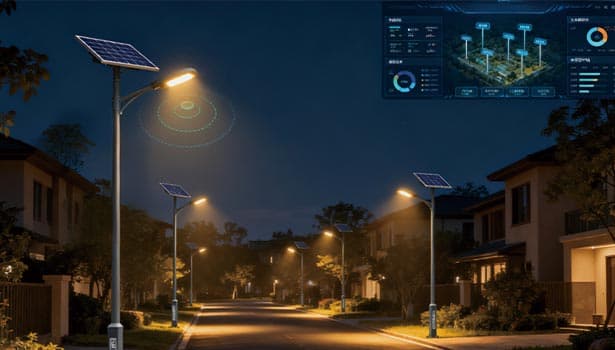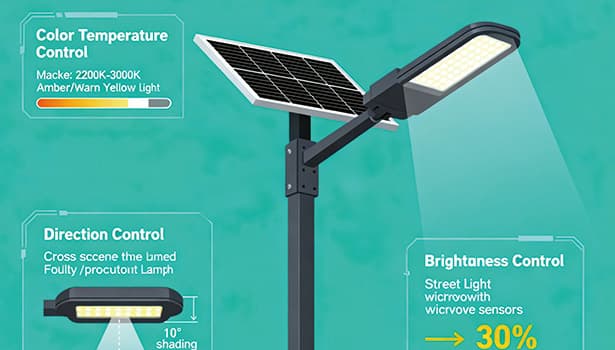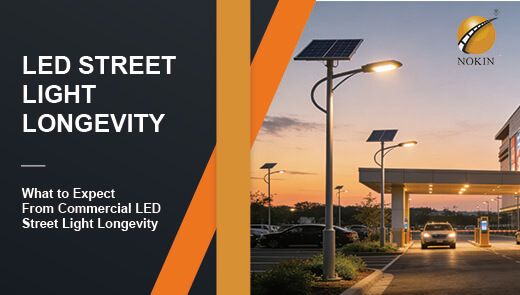Reduce Lighting Pollution with Solar Street Light Design
After nightfall, the city is enveloped by dense artificial light - the strong light from the main roads, the ever-burning lights in the communities and the neon lights of the shops interweave into a light network. Data shows that 80% of urban residents worldwide cannot see the Milky Way with the naked eye, and over 70% of towns in China have a night sky brightness that is more than ten times brighter than in its natural state.
This environmental problem, known as "light pollution", is quietly eroding the ecology and daily life. Traditional high-pressure sodium street lights not only consume a lot of energy, but their unobstructed light design also causes over 30% of the light to leak into the sky and non-essential areas, making them the main contributor to light pollution.
In fact, solar street lights are by no means as simple as just being powered by solar energy. Through systematic design of light source selection, light structure and intelligent control, it can not only achieve zero-carbon lighting relying on photovoltaic technology, but also become the core carrier for precise control of light pollution. This article will start from the essence of light pollution and dissect the anti-pollution design logic and practical path of solar street lights.

The Essence, Forms and Multiple Hazards of Light Pollution
The Definition and Main Forms of Light Pollution
Light pollution refers to the imbalance of the night environment caused by the "excessive emission" and "loss of direction control" of artificial light, mainly manifested in three forms:
Glare:
The strong light produced by direct or reflected light sources exceeds the tolerance of the human eye. For instance, the exposed light heads of traditional street lights can cause drivers to temporarily "go blind", increasing the risk of night driving.
Bright sky:
A large amount of upward escaping light combines with atmospheric dust, forming a "light fog" above the city, making the night sky appear grayish-white and completely obscuring the stars.
Light intrusion:
Light crosses the lighting boundary and enters non-target areas, such as the light from street lights shining into residents' bedrooms, disturbing sleep. Or invade nature reserves and damage the night environment of habitats.
The Chain Hazards of Light Pollution
"Nighttime disasters" of the ecosystem
Nocturnal organisms are the direct victims of light pollution. Migratory birds rely on stars and the moon for navigation. Urban light and fog can cause them to deviate from their migratory routes. Every year, over one billion migratory birds worldwide get lost due to light pollution. Nocturnal insects are sensitive to light. High-brightness lights can cause them to gather and die, thereby disrupting the food chain of birds and frogs. Even earthworms in the soil will reduce their activities due to the overly bright surface, affecting soil fertility.
The "invisible killer" of human health
The human body's biological clock relies on the alternating regulation of light and dark during the day and night. Excessive light exposure at night can inhibit the secretion of melatonin. A study by the World Health Organization shows that people who are exposed to light pollution for a long time have a 40% higher incidence of sleep disorders and a 25% higher risk of diseases such as hypertension and depression. Hospital data shows that the rate of insomnia visits among residents facing the street is three times higher than that among residents on the inner side of the community.
The double loss of culture and economy
The starry sky is a shared cultural heritage of mankind. However, light pollution has made astronomical observation a luxury. Due to light interference in the urban area, the observation efficiency of the Beijing Astronomical Observatory has dropped by 60% compared to that in the suburbs. Meanwhile, "dark night tourism" as a new form of eco-tourism is being blocked by light pollution: Due to road light pollution around Meili Snow Mountain in Yunnan Province, the number of tourists on the starry sky observation route has decreased by 35% compared with 2015.
3 Logics for Solar Street Lights to Reduce and Control Light Pollution
The anti-pollution design of solar street lights is not a single-point optimization, but rather a three-logical closed loop established around "precise light supply" :
Color temperature control:
By choosing a low-color-temperature light source, the interference of light on biological rhythms is reduced, and light scattering is decreased.
Direction control:
By means of the structural design of the lights, the light is locked in the target area to prevent upward escape and cross-border leakage.
Brightness control:
Relying on intelligent technology to achieve "on-demand lighting", it avoids waste and pollution caused by high-intensity light emission throughout the day.
These 3 logics support each other and jointly achieve the goal of environmentally friendly lighting that is "bright enough but not dazzling, useful but not wasteful".
The Design of Light Sources and Lights for Solar Street Lights
Light sources and lights are the first line of defense against light pollution, and their design directly determines the nature and direction of light.
The Scientific Selection of Low Color Temperature LED Light Sources
Traditional street lights mostly use high-color-temperature leds with a color temperature of over 4000K, which have a high proportion of blue light components. This not only leads to strong scattering and easy formation of natural light but also seriously disrupts the circadian rhythm of living organisms. Solar street lights should give priority to using low-color-temperature light sources. The specific parameter comparisons are as follows:
|
Color Temperature Range |
Light Color Characteristics |
Light Pollution Risk |
Applicable Scenarios |
Ecological Friendliness |
|
2200K – 2700K |
Amber / Warm Yellow |
Extremely Low |
Surrounding nature reserves, community trails |
★★★★★ |
|
2700K – 3000K |
Warm White |
Low |
City secondary roads, parks |
★★★★☆ |
|
3000K – 4000K |
Neutral White |
Medium |
Main roads (areas requiring high recognition) |
★★☆☆☆ |
|
Above 4000K |
Cold White |
High |
Industrial plant areas (non-ecologically sensitive) |
★☆☆☆☆ |
Data shows that for LED light sources of 3000K and below, the light scattering is reduced by 58% compared to 4500K light sources, and the attraction rate to nocturnal insects is decreased by 70%. Moreover, the energy efficiency (lumens per watt) of this type of light source is basically on par with that of high-color-temperature products, and the procurement cost is only 5% to 8% higher, making it economically feasible.
Among them, amber (2200K-2500K) and red light sources are the best choices for ecologically sensitive areas. A study by the University of Cambridge in the UK shows that red light causes almost zero navigation interference to bats. After solar street lights were used on rural roads, the frequency of bat activities at night returned to 92% of the natural level.
The Structural Design of Fully Cut-Off Luminaires
The structure of the light determines the direction of light projection. The Full Cut-Off design is the key to preventing the upward escape of light. Its core requirement is that "the light does not leak upward beyond the horizontal direction". The specific design points include:
Shading angle optimization:
The top and sides of the light are equipped with arc-shaped shading covers, with a shading Angle of no less than 10°, ensuring that all the light emitted by the light beads is confined within the downward range.
Narrow-angle light distribution:
Select optical lenses with a light distribution curve Angle of less than 120° to precisely focus the light on the road surface and prevent it from diffusing to the sidewalks or building areas on both sides.
Sealed structure:
The light body adopts an IP67-level sealed design, which not only prevents dust from entering and affecting the luminous efficiency, but also avoids light leakage through gaps and light intrusion.

The Intelligent Control System of Solar Street Lights
"Excessive lighting" is a significant cause of light pollution. The intelligent control system achieves dynamic adaptation of light through a closed loop of "perception - regulation - control".
Sensor-Driven Dynamic Regulation
The sensor is the "sensing organ" of solar street lights. The core configuration includes:
- Microwave motion sensor:
With a detection distance of up to 15 meters, it can accurately identify pedestrians and vehicles. When an active target is detected, the brightness will be automatically increased to 100%. Thirty seconds after the target leaves, the brightness drops to 30% of the base illuminance, ensuring safety while reducing waste.
- Ambient light sensor:
It monitors the intensity of natural light in real time. When the ambient light brightness exceeds 50lux at dawn, it automatically turns off the street lights. Start it only when the lux drops below 10 at dusk to avoid supplementary light pollution caused by false lighting during the day or premature extinguishing at night.
Customized Lighting Strategy Programming
According to the usage requirements of different regions, differentiated lighting curves can be preset. The typical scene strategies are as follows:
- Main road strategy:
100% brightness from 18:00 to 22:00 (peak traffic hours), 50% brightness from 22:00 to 5:00 (off-peak hours), and gradually increase from 50% to 100% from 5:00 to 6:30 (morning driving hours).
- Community trail strategy:
80% brightness from 18:00 to 21:00, 30% brightness from 21:00 to 6:00, and only trigger high brightness when someone passes by.
- Scenic area road strategy:
70% brightness from 18:00 to 20:00, and reduced to 20% amber dim light after 20:00 to avoid affecting starry sky observation.
Remote Intelligent Control and Management
With the help of LoRa or NB-IoT wireless communication technology, remote management of street light clusters can be achieved:
Real-time control:
Through the background system, operation and maintenance personnel can adjust the brightness and on/off time of street lights individually or in batches to deal with sudden weather or activity demands.
Data feedback:
The system automatically collects data such as the lighting duration, brightness variation, and photovoltaic power generation of each solar street light, generating a light pollution assessment report to provide a basis for strategy optimization.
Fault Warning:
When the light shows abnormal brightness (such as continuous high brightness), the system immediately sends a warning to prevent light pollution caused by faults.
System Optimization of Solar Street Lights
The stability of the solar street light system directly affects the implementation effect of the anti-pollution design. If the photovoltaic power supply is insufficient, causing the light to flicker on and off, it will instead aggravate light pollution.
High-Efficiency Light Sources are Matched with Photovoltaic Systems
Selection of high-luminous efficiency leds
NOKIN solar street lights prioritize the use of LED beads with a luminous efficacy of ≥150lm/ W. Compared with traditional products with a luminous efficacy of 100lm/W, under the same illuminance requirements, the power can be reduced by 33%. Take the lighting of main roads as an example. When a 30lux illuminance is required, a 150lm/W LED only needs 30W of power, while traditional products require 45W. The reduced power consumption directly lowers the risk of light pollution.
Precise configuration of photovoltaic modules
The size and installation Angle of photovoltaic panels need to be customized in accordance with the local climate. The core calculation factors include:
- Average annual sunshine duration: For instance, in Lhasa (over 3,000 hours), smaller-sized photovoltaic panels can be selected; in Chengdu (around 1,200 hours), the area needs to be increased by 20%.
- Peak sunlight exposure: The installation Angle is determined based on latitude. The optimal Angle in the Northern Hemisphere is "latitude + 10°", ensuring that direct strong sunlight is avoided in summer and more sunlight is absorbed in winter.
- Energy storage requirements: The battery capacity must be sufficient to supply power for three consecutive rainy days to prevent the lighting strategy from failing due to insufficient power during rainy days.
For instance, in Shanghai (31° north latitude, with an annual sunshine duration of 1,600 hours), a 30W LED street light needs to be paired with a 120W monocrystalline silicon photovoltaic panel (conversion efficiency ≥23%) and a 100Ah lithium battery to ensure stable operation.
Environmentally Friendly Design Throughout the Entire Life Cycle
The environmental protection attribute of solar street lights should run through the entire life cycle:
Selection of recyclable components:
The light post is made of aluminum alloy (with a 100% recycling rate), and the lightshade is made of PC engineering plastic (with a 90% recycling rate). Traditional lighting materials containing mercury and lead are avoided.
Modular design:
Photovoltaic panels, LED beads, and batteries are assembled in a modular way. During later maintenance, components can be replaced separately, extending the product's lifespan to over 10 years and reducing pollution from discarded lights.
Waste battery disposal:
Cooperate with professional institutions to establish a battery recycling system, and carry out secondary utilization of lithium batteries (such as in energy storage power stations) to prevent electrolyte leakage and soil pollution.

The anti-pollution design of solar street lights can not only effectively reduce problems such as glare, daylight brightness and light intrusion, but also promote the transformation of urban lighting from "extensive supply" to "precise service". Solar street lights are no longer simple lighting tools, but important carriers for urban ecological governance.
In the future, with the integration of AI algorithms and Internet of Things (iot) technology, solar street lights will achieve more intelligent light pollution control - by learning the patterns of local pedestrian and vehicle flows, they will automatically generate the optimal lighting strategies. It can even be linked with the meteorological system to adjust the brightness according to the thickness of the cloud layer, truly achieving "coexistence with nature" in night lighting.




